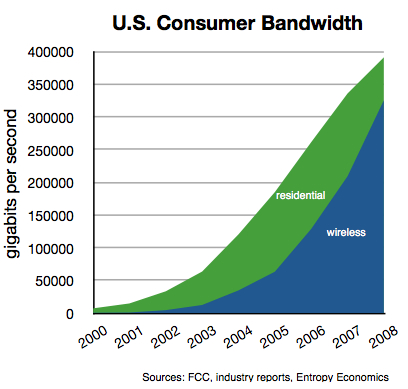The venerable Economist magazine has made a hash of my research on the growth of the Internet, which examines the rich media technologies now flooding onto the Web and projects Internet traffic over the coming decade. This “exaflood” of new applications and services represents a bounty of new entertainment, education, and business applications that can drive productivity and economic growth across all our industries and the world economy.
But somehow, The Economist was convinced that my research represents some “gloomy prophesy,” that I am “doom-mongering” about an Internet “overload” that could “crash” the Internet. Where does The Economist find any evidence for these silly charges?
In a series of reports, articles (here and here), and presentations around the globe — and in a long, detailed, nuanced, very pleasant interview with The Economist, in which I thought the reporter grasped the key points — I have consistently said the exaflood is an opportunity, an embarrassment of riches.
I’ve also said it will take a lot of investment in networks (both wired and wireless), data centers, and other cloud infrastructure to both drive and accommodate this exaflood. Some have questioned this rather mundane statement, but for the life of me I can’t figure out why they deny building this amazingly powerful global Internet might cost a good bit of money.
One critic of mine has said he thinks we might need to spend $5-10 billion on new Net infrastructure over the next five years. What? We already spend some $70 billion a year on all communications infrastructure in the U.S. with an ever greater portion of that going toward what we might consider the Net. Google invests more than $3 billion a year in its cloud infrastructure, Verizon is building a $25-billion fiber-to-the-home network, and AT&T is investing another $10 billion, just for starters. Over the last 10 years, the cable TV companies invested some $120 billion. And Microsoft just yesterday said its new cloud computing infrastructure will consist of 20 new “super data centers,” at $1 billion a piece.
I’m glad The Economist quoted my line that “today’s networks are not remotely prepared to handle this exaflood.” Which is absolutely, unambiguously, uncontroversially true. Can you get all the HD video you want over your broadband connection today? Do all your remote applications work as fast as you’d like? Is your mobile phone and Wi-Fi access as widespread and flawless as you’d like? Do videos or applications always work instantly, without ever a hint of buffer or delay? Are today’s metro switches prepared for a jump from voice-over-IP to widespread high-resolution video conferencing? No, not even close.
But as we add capacity and robustness to many of these access networks, usage and traffic will surge, and the bottlenecks will shift to other parts of the Net. Core, edge, metro, access, data center — the architecture of the Net is ever-changing, with technologies and upgrades and investment happening in different spots at varying pace. This is not a debate about whether the Internet will “crash.” It’s a discussion about how the Net will evolve and grow, about what its capabilities and architecture will be, and about how much it will cost and how we will govern it, but mostly about how much it will yield in new innovation and economic growth.
The Economist and the myriad bloggers, who everyday try to kill some phantom catastrophe theory I do not recognize, are engaging in the old and very tedious practice of setting up digital straw men, which they then heroically strike down with a bold punch of the delete button. Ignoring the real issues and the real debate doesn’t take much effort, nor much thought.



